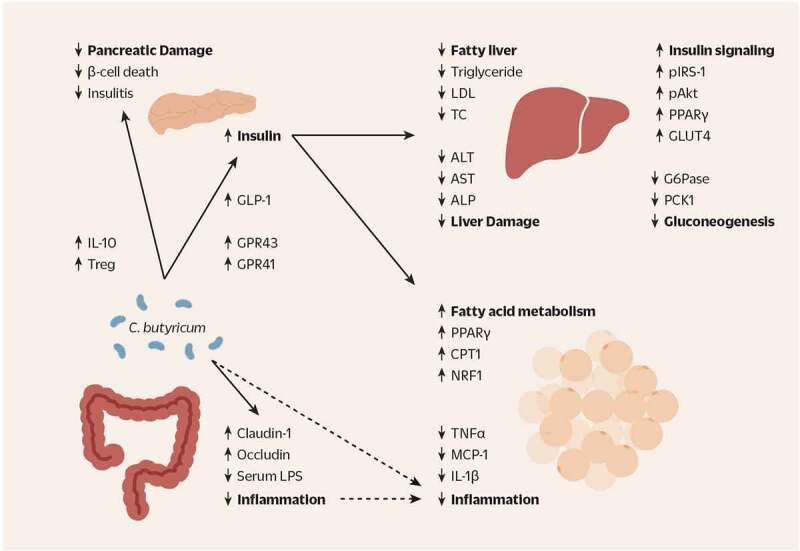Figure 5.

The proposed beneficial effects of C. butyricum strains in the gut, pancreas, liver, and adipose tissue of individuals with metabolic disease. C. butyricum increases the concentration of SCFA as well as the abundance of butyrate-producing bacteria in the gut. The increased secretion of GLP-1 in the colon and the bloodstream can be attributed to the increased SCFA receptor signaling via GPR41 and GPR43. GLP-1 has pleiotropic effects across many organs in reducing appetite, slowing gastrointestinal motility, decreasing gluconeogenesis and increasing glucose uptake, and most importantly, increasing secretion of insulin from the pancreas. As such, in the liver C. butyricum increases insulin signaling (pIRS-1, pAkt, PPAR-γ, GLUT4) and decreases gluconeogenesis (G6Pase and PCK1). Serum markers of hepatic lipid storage such as triglyceride, LDL, and TC are decreased, indicating improved lipid metabolism. Concurrently, the markers of hepatic damage (ALT, AST and ALP) are decreased as well. In the adipose tissue, C. butyricum upregulates genes involved in mitochondrial fatty acid oxidation, indicating enhanced fatty acid metabolism: PPAR-γ, CPT1α, and NRF2. Finally, pro-inflammatory cytokines TNF-α, IL-1β, and MCP1 are decreased in the adipose tissue. Such anti-inflammatory effect may be associated with the direct effect of C. butyricum-produced metabolites such as butyrate, indirect effects of butyrate such as increased GLP-1 signaling and insulin secretion, and/or the decreased gut inflammation due to healthier gut epithelium evidenced by increased tight junction proteins claudin-1 and occludin and increased levels of serum LPS. Additionally, the population of Tregs and the level of anti-inflammatory cytokine IL-10 are increased due to C. butyricum, contributing to the reduced inflammation in the other organs, allowing proper insulin secretion and energy metabolism
SCFA: short chain fatty acid; GPR41/43: G-protein-coupled receptor 41/43; GLP-1: glucagon-like peptide 1; pIRS-1: phosphorylated insulin receptor substrate 1; pAkt: phosphorylated Akt; PPAR-γ: peroxisome proliferator-activated receptor-gamma; GLUT4: glucose transporter type 4; g6pase: glucose-6 phosphatase; PCK1: phosphoenolpyruvate carboxykinase 1; LDL: low density lipoprotein; TC: total cholesterol; ALT: alanine transaminase; AST: aspartate aminotransferase; ALP: alkaline phosphatase; CPT1α: carnitine palmitoyltransferase-1α; NRF2: nuclear factor erythroid 2-related factor 2; TNF-α: tumor necrosis factor alpha; IL-1β: interleukin-1 beta; MCP1: monocyte chemoattractant protein 1; LPS: lipopolysaccharide; Treg: regulatory T cell; IL-10: interleukin 10
